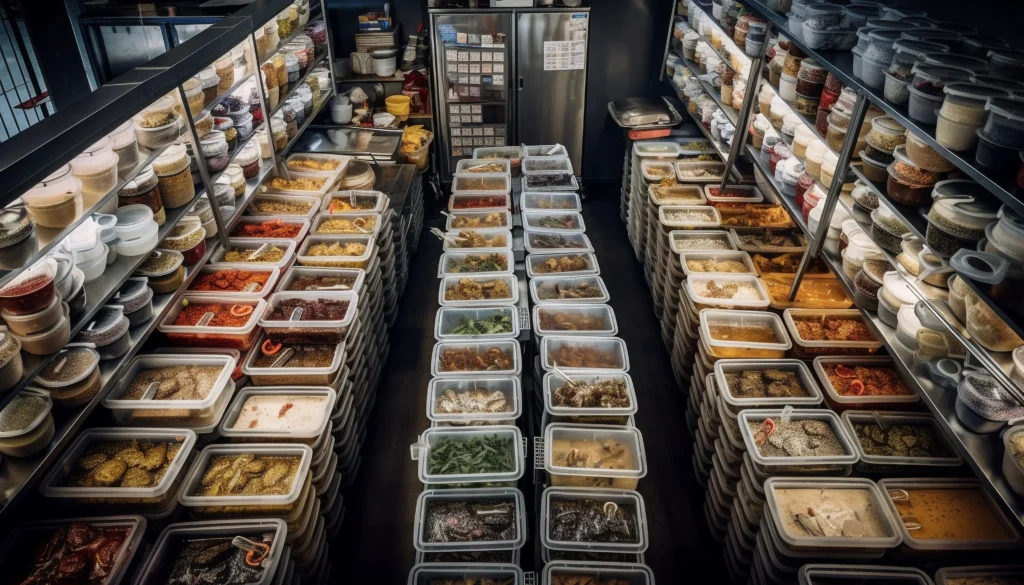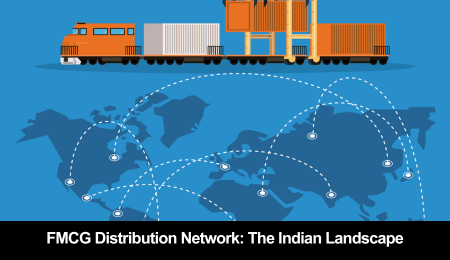FMCG Distribution Network: The Indian Landscape
We rely on Fast-Moving Consumer Goods (FMCG) in our daily lives for items like food, drinks, dairy products, tea, toothpaste, and candies. We use these products so frequently that they quickly disappear from store or supermarket shelves. Even though these products are so common, we often don’t think about how they reach us. However, there is a whole system behind it called the FMCG distribution network. It is like a big invisible delivery system that makes sure these products are available everywhere, from big cities to small towns and villages.
The process starts with manufacturing, storing, and packing FMCG (fast-moving consumer goods) products.Distributors are responsible for delivering these products to grocery stores, supermarkets, and other retailers in various towns and cities. Transportation helps move the goods to different locations easily. After that, the products finally reach us, the end consumers. The whole process ensures that products are delivered to us easily and on time so that people can use them in need.
An effective and well-managed logistics system that can handle large inventory loads and respond quickly to customer needs is key to the success of any FMCG distribution strategy. The FMCG industry is the fourth largest sector in India and was valued at around 100-110 billion USD (approximately 8-9 trillion INR) yearly in 2020. In this article we will explore how the vast diversified landscape of India impacts the distribution of fmcg products.
Let’s get started.

The Crucial Role of Wholesalers and Distributors in an FMCG Distribution Network
In an FMCG distribution network, intermediaries such as wholesalers and distributors play an essential role, especially when it comes to connecting with small stores and remote regions of India. Wholesalers purchase items in larger quantities from manufacturers to save money and provide convenience, then resell them to retailers in smaller amounts.
FMCG distributors act as mediators, managing logistics and distribution networks to ensure that goods are effectively delivered to distant regions. These intermediaries are crucial for linking producers with small merchants and rural customers in India, where infrastructure is limited. This helps make items more easily accessible in a variety of markets through the fmcg distribution channel.
Impact of India’s Diverse Geography on FMCG Distribution Channel
India’s geography, which covers a vast region from the Himalayas to the southern plains, has a major impact on the distribution of goods and services. In big cities like Mumbai, Delhi, and Bangalore, where transportation is efficient, distribution is successful due to high population density and good connectivity.
However, urban and rural areas face challenges due to limited infrastructure, smaller vehicles, and the use of traditional supply chains. Remote hilly areas face even greater obstacles because difficult terrain and limited connectivity lead to higher costs and delays in the distributorship of fmcg products.
To solve these issues, technology-based solutions like route optimization and GPS tracking can increase efficiency in all sectors. Partnering with local groups, as well as investing in infrastructure like transportation and warehouses, is beneficial for distribution networks. Adopting these techniques may assist businesses in navigating India’s developing landscape, ensuring effective coverage, and improving supply chain efficiency and customer satisfaction.
Urban and Rural Market Dynamics
The Union budget for 2023-24 aimed to boost rural demand by increasing disposable income, supporting farmers, and improving rural infrastructure. Compared to cities, rural areas face challenges such as insufficient internet access and limited availability of retailers. While urban areas generate the most revenue, rural India is also experiencing rapid growth.
As internet connectivity expanded to rural areas, the demand for online shopping increased greatly. These developments in rural areas for FMCG include more distributors and retail outlets. The government assists people in rural areas by raising the minimum support prices for farmers (MSPs) and forgiving debts to farmers through programs such as NREGA.

Importance of Kirana (Mom-and-Pop) Stores
Kirana (mom-and-pop) stores are crucial for the distribution of FMCG products in India accounting for nearly 80% of FMCG sales. These small independent retailers, often located in residential areas, provide easy access to customers. They offer personalized service, understand customer preferences, and frequently provide flexible credit options, especially for low-income households.
In remote areas, kirana stores act as important last-mile distributors, effectively connecting FMCG manufacturers with consumers. These stores have in-depth knowledge of local markets and customer needs, playing a vital role in stocking relevant products and adapting to changing demands. Overall, kirana stores are not just places to shop but pillars of community engagement and customer trust in the FMCG distribution network.
Shift of FMCG Distribution network towards modern retail formats:
India currently has only 8% of the structured retail distribution network, but this number is exponentially increasing. The retail sector in India is transforming rapidly, with a growing shift towards modern retail formats like supermarkets, hypermarkets, and department stores. These modern stores cater to the changing needs of consumers, offering convenience, wider product selection, and competitive pricing.
However, traditional general stores still play a crucial role, especially in rural areas, due to their deep reach and community relationships. Additionally, the rise of quick commerce services like Swiggy Instamart and Blinkit is disrupting the retail landscape by offering ultra-fast delivery of groceries and essentials. Adaptation and embracing technological advancements are key for both traditional and modern retailers to succeed in this dynamic environment.
Rise of E-commerce and Online Marketplaces
E-commerce is helping businesses by utilizing data and statistics to better understand consumer purchasing trends. The growth of e-commerce has significantly changed the way fmcg products distributorship works in India, having a major impact on the industry. To meet the needs of online marketplaces, businesses must now optimize their supply chain for efficient delivery and returns management.
Companies have taken serious steps to improve their logistics processes and management to meet the rising expectations of consumers for swift and secure delivery. Though a growing sector, Ecommerce does pose some challenges and businesses are addressing these challenges with flexibility and adaptability by ensuring timely delivery, proper inventory management, and handling returns smoothly through effective supply chain management.
Role of Direct Sales and Institutional Buyers for an expanded FMCG Distribution Network
Growing B2B connections with hotels, restaurants, and companies is crucial for the success of the fmcg distribution network. Direct sales to these buyers not only increase earnings but also build trust and reliability. Customizing products to meet unique needs enhances consumer satisfaction and loyalty.
These connections drive growth, expand markets, and provide a competitive edge. Direct buyers purchase in bulk, boosting sales and reducing distribution costs. Their feedback helps FMCG companies understand what consumers prefer. Institutional buyers provide consistent demand, ensuring stable income for long-term planning. Serving both types of buyers expands the customer base, boosts sales, and makes the brand stronger in the market.
Catering to Cultural and Regional Diversity
FMCG distribution techniques are strongly influenced by the multiple cultural and regional preferences found across India. It is crucial that FMCG companies understand these differences in order to properly reach and serve consumers in different states. For example, food preferences vary – northern areas prefer wheat-based products, while southern regions focus on rice.
Festive traditions, language differences, and packaging preferences all influence how customers behave and select products. To cater to local languages and tastes, products might come with different labels and packaging in various regions, which is also a part of the distribution model of fmcg companies. Ensuring relevance and success in diverse markets, FMCG companies must adapt their distribution networks, product ranges, and marketing strategies in accordance with the various cultural and regional preferences across India.
Technological Advancements in FMCG Distribution
Digitalization and document management systems (DMS) are two technological innovations that are transforming FMCG distribution management in India. DMS reduces paperwork, improves data accuracy, and enhances document accessibility, making order processing and inventory management more efficient.
Digitization enables real-time tracking of shipments, inventory levels, and sales data, enabling better decision-making and inventory optimization. By implementing these technologies, FMCG distribution companies can increase supply chain efficiency, reduce operating costs, and improve transparency, providing them a competitive advantage in the Indian market and better customer service.
Key Challenges in the FMCG Distribution Network in India (with solutions)
Despite strong fundamentals, the FMCG distribution sector in India faces several challenges:
- Inventory Management: It can be difficult for FMCG companies to maintain a balance between meeting changing demand and minimizing shortages or overstocking.
- Shipping Errors: Inaccurate shipments, delays, or damaged items during transportation can result in dissatisfied customers and financial losses.
- Forecasting Accuracy: Accurately forecasting demand is challenging due to varying customer preferences and seasonal changes across different parts of India.
Potential solutions include:
- Advanced Inventory Systems: Utilizing advanced inventory management systems can help monitor stock levels, predict demand, and automate replenishment processes.
- Enhanced Quality Control: Investing in quality assurance procedures and reliable shipping processes can reduce errors, increase delivery efficiency, and improve customer satisfaction.
- Data-Driven Forecasting: By leveraging market information and analytics, forecasting accuracy can be improved, allowing FMCG companies to predict demand trends and optimize supply chain operations accordingly.
Conclusion:
The FMCG distribution network in India faces complexities stemming from the nation’s vast geography, cultural diversity, and varied consumer preferences. To navigate these challenges effectively, companies must embrace digitalization, data-driven decision-making, and forge strategic partnerships.
By optimizing supply chains, understanding regional nuances, and adopting innovative solutions, FMCG businesses can ensure efficient product availability, enhance customer satisfaction, and unlock sustained growth opportunities across India’s dynamic markets.


Leave a Comment